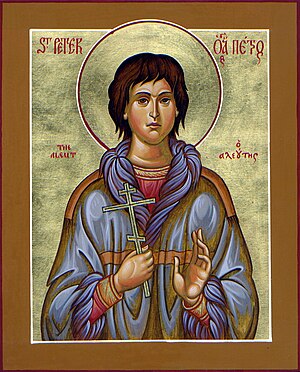Peter the Aleut
| Saint Peter the Aleut | |
|---|---|

Icon of St. Peter the Aleut
|
|
| Martyr of San Francisco and Protomartyr of America | |
| Born | c. 1800 |
| Died | 1815 |
| Venerated in | Eastern Orthodox Church |
| Canonized | 1980 by Orthodox Church in America |
| Feast | September 24 |
| Attributes | portrayed as an Aleut youth, wearing a traditional gut parka |
Cungagnaq (date of birth unknown - d. 1815) is venerated as a martyr and saint (as Peter the Aleut) by some jurisdictions of the Eastern Orthodox Church. He was allegedly a native of Kodiak Island (Alutiiq or Sugpiaq), and is said to have received the Christian name of Peter when he was baptized into the Orthodox faith by the monks of St. Herman's missionaries operating in the north. He is purported to have been captured by Spanish soldiers near "San Pedro" and tortured and killed at the instigation of Roman Catholic priests either there or at a nearby location. At the time identified for his death, California was Spanish territory, and Spain was worried about Russian advances southwards from Alaska.Hubert Howe Bancroft, in his multi-volume History of California, only notes that, in connection with an incident wherein a Russian fur-hunting expedition was taken into custody after declining to leave San Pedro; one Russian source accused "the Spaniards of cruelty to the captives, stating that according to Kuskof’s report one Aleut who refused to become a Catholic died from ill-treatment received from the padre at San Francisco."
According to the most fully developed version of the story, in 1815 a group of Russian employees of the Russian American Company and their Aleut seal and otter hunters, including Peter, was captured by Spanish soldiers, while hunting illicitly for seals near San Pedro, (which has variably been interpreted as either San Pedro, Los Angeles or as San Pedro y San Pablo Asistencia (in Pacifica, California). According to the original account, the soldiers took them to "the mission in Saint-Pedro" for interrogation. One Russian source states that after being taken prisoner near modern Los Angeles, the captives were taken to Mission Dolores—that is, modern San Francisco. With threats of torture, the Roman Catholic priests attempted to force the Aleuts to deny their Orthodox faith and to convert to Roman Catholicism.
...
Wikipedia
